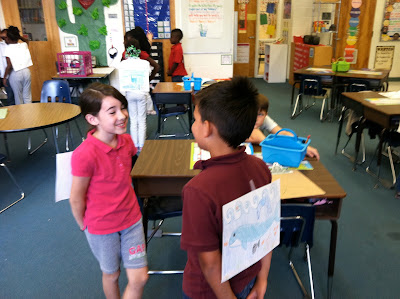Oh, workstations...where do I even begin?! My love for workstations began throughout my student teaching. There was something purely magical about meeting with differentiated small groups in peace while the rest of the class remained fully engaged without constant interruptions.

As a student teacher I developed 'centers.' This was a giant headache as it required digging for new ideas every week and staying after hours on Friday (crazy! I know!). Looking back I realize that the concept of 'centers' was great but the overall product was silly.
Thank my lucky stars for Debbie Diller, the author of
Literacy Workstations and
Making the Most of Small Group Instruction. Every single last page of my copies have highlighted lines and notes in the margin. Once you read her books, you will realize the simple distinction between the age old 'centers' and the newly evolved 'literacy workstations.'
Here are some of my students in action!
At the
ABC/Word Study Station these students are completing an activity related to the reading curriculum story about space. The activity involves reading long/short o sounds, sorting them on the correct word mat and recording the answers. Even science is integrated into reading with the activity relating to space! LOVE IT!
This
Pocket Chart Station reviews fact and opinion. The students read each moon phrase and place them in pockets under the correct category while recording answers. Notice how I have students paired. This is so they can help each other stay on task or figure things out if they are confused.
 |
| Pocket Chart Station |
The W
riting Station can involve so many activities. Here, one student is creating a simile book about the moon while the other is practicing his spelling words with rainbow colors. So simple...yet so effective.
The
Big Book Station is a class favorite. Students take turns using funky pointers (this is a fly swatter from the Dollar Tree) to read each line or page of the story. Throughout the year we practiced reading stories with funny voices, asking partners questions at the end, and even sharing a favorite part to the class.
Read the Room Station is so easy because it is portable and can be placed ANYWHERE with some clipboards and a basket. This student is finding words with soft/hard g and c sounds.
Not pictured are my Library Station, Buddy Reading Station, Computer Station, Smartboard Station, iPad Station, Listening Station, and Nonfiction Station. The options are truly endless.
I found these particular activities on Teachers Pay Teacher, which is a GOLD MINE if you are looking for inexpensive pre-made activities and lessons.
 Hi friends! Up next is another goodie that I found on Pinterest to practice our weekly reading skill, problem and solution. Click here to get your FREE copy from Ashley's store on TPT.
Hi friends! Up next is another goodie that I found on Pinterest to practice our weekly reading skill, problem and solution. Click here to get your FREE copy from Ashley's store on TPT..JPG)





































